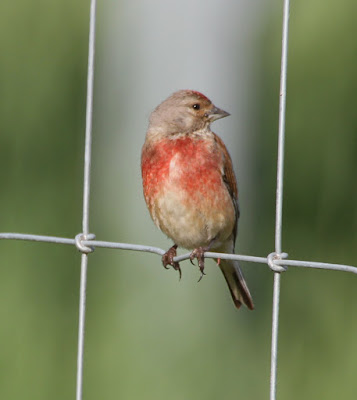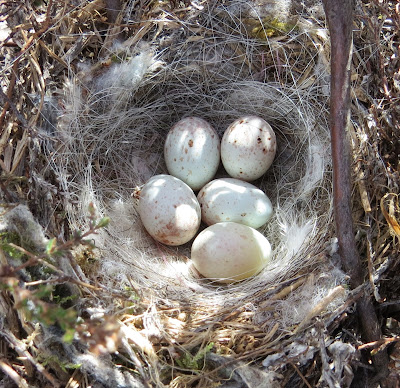A Beautiful Sunrise
belies the true conditions as the wind sticks doggedly in that
North Easterly Quadrant
not at all conducive with adequate returns from the Moth Traps.
To be fair if every Moth in the World decided to visit our traps it would
still be a case of wanting more, and in fact we ain't doin' too badly!
New for the Year have been
DARK-BARRED TWIN-SPOT CARPET
CHINESE CHARACTER
(looking more like a small deposit left by the local Robin)
MAIDEN'S BLUSH
(unfortunately a little dog-eared)
PALE MOTTLED WILLOW
along with the first
MAY BUG or COMMON COCKCHAFER or DOODLEBUG
It had been the intention some time ago to post an update on the matter of
PROCREATION
hereabouts, but with one thing or another that had suffered the 'back-heel' until now.
Firstly, and thought most unexpected by most of us the arrival of a
CRIA
a baby
ALPACA
It is not known how the mother was inseminated but enquiries continue on that matter.
To continue the now long drawn out saga of the
Gravel Pit
LITTLE GREBE
on one occasion the were found not only both absent from the nest,
but also seemingly from the entire watercourse. Knowing just how skulking these tiny
waterbirds can be there was no concern, but the opportunity was taken to view
the nest a little close, which was found to contain
c2 EGGS
At the next visit, the following day, a 'sitting bird had returned
and all seemed normal but subsequently both birds then abandoned
the nest completely, spending all of their time at the opposite end of the watercourse.
the nest completely, spending all of their time at the opposite end of the watercourse.
A final close inspection was made with the nest found to be empty,
since when we have been hoping to catch sight of chicks - but unfortunately NO!
It is considered to be a 'great priveledge' to view this 'floating nest' at such close quarters,
with the haphazard weaving of the main structure and a covering of equally wet and
green vegetation for the eggs.
It is considered to be a 'great priveledge' to view this 'floating nest' at such close quarters,
with the haphazard weaving of the main structure and a covering of equally wet and
green vegetation for the eggs.
........ to be continued.
It should also be report that during this period Lapwing have also appeared interest
in the shingle bed at the same end of the lake.
Meanwhile along the course of the
MOORS RIVER
another
MUTE SWAN
nest has been found, to compliment the other at Parley Pond.
Unlike that site here on the river both
REED WARBLER
(song only)
and
REED BUNTING
have been vocal, hopefully the precursor to breeding.
On the Heath things have not been quite so rosy with absolutely
no evidence of
DARTFORD WARBLER
nesting, only the gentle rasping from cover and these brief appearances from time to time.
Not even a sighting as far as Woodlark are concerned while we wait for at least
a pair of Tree Pipit to linger, there was a lone bird there last Thursday.
However, there is a slightly brighter side as
STONECHAT
are actively feeding young.
"Oh to be a Spider now that Spring is here"!
or is that suppose to be "in England"?
LINNET
are sitting on eggs
and daily but distant observations continue at the
GREAT SPOTTED WOODPECKER NEST
Since excavating ceased there has only been one brief sign of life as the
female, thought to be incubating, came to the lip of the nest, exited and flew off
only to return 10 minutes later and quickly disappear into the cavern.
A quick snack me thinks?
no evidence of
DARTFORD WARBLER
nesting, only the gentle rasping from cover and these brief appearances from time to time.
Not even a sighting as far as Woodlark are concerned while we wait for at least
a pair of Tree Pipit to linger, there was a lone bird there last Thursday.
However, there is a slightly brighter side as
STONECHAT
are actively feeding young.
"Oh to be a Spider now that Spring is here"!
or is that suppose to be "in England"?
LINNET
are sitting on eggs
and daily but distant observations continue at the
GREAT SPOTTED WOODPECKER NEST
Since excavating ceased there has only been one brief sign of life as the
female, thought to be incubating, came to the lip of the nest, exited and flew off
only to return 10 minutes later and quickly disappear into the cavern.
A quick snack me thinks?
It is said that "it never strikes in the same place twice",
but if you have ever bothered to read the 'small print" you will see it clearly states
"unless you are an Alpaca".
"unless you are an Alpaca".
Blimey, there's another, a BLACK one this time
which my Sherpa and in-house consultant on all things
ANDEAN
(John Gifford)
informs me are far more sort after for their wool,
which by definition commands a far higher price.
ANDEAN
(John Gifford)
informs me are far more sort after for their wool,
which by definition commands a far higher price.
Harking back to the ponds, in more recent days, seems we were right about the
prospecting the Gravel Pit as a potential nesting site,
but completely wrong about the location!
This lone bird has spent most of the time at the entrance end of the lake
and by a complete fluke we located the
With the chunk of 'red brick' acting as an ideal indicator as to position we
can now keep watch from a safe distance without running over or stepping on it.
This lone bird has spent most of the time at the entrance end of the lake
and by a complete fluke we located the
NEST
on our way out.With the chunk of 'red brick' acting as an ideal indicator as to position we
can now keep watch from a safe distance without running over or stepping on it.
However, there has not been quite so much good fortune back at the
Irrigation Pond
in recent days as the female
COOT
Irrigation Pond
in recent days as the female
COOT
continued to sit, over what is considered to have been an inordinately long incubation period.
Then, all of a sudden the male bird started delivering food which was taken
by the missus and past to the hatchlings below.
by the missus and past to the hatchlings below.
Some good news at long last, but unfortunately short lived.
Within 48 hours the nest had been cleared of its occupants,
with the parent birds remaining in the area and the nest left to the elements.
Within 48 hours the nest had been cleared of its occupants,
with the parent birds remaining in the area and the nest left to the elements.
What might have redressed this was the attendance of another pair of
LITTLE GREBE
with all the room in the world started constructing a nest
right under the noses of the Coot
at the near right hand corner of the
Floatation Unit.
After 2 days of concerted effort they abandoned the project
to start another in the opposite corner.
Since then, that too has been neglected with the pair of Grebes now
just floating around the pond twiddling their thumbs.
LITTLE GREBE
right under the noses of the Coot
at the near right hand corner of the
After 2 days of concerted effort they abandoned the project
to start another in the opposite corner.
Since then, that too has been neglected with the pair of Grebes now
just floating around the pond twiddling their thumbs.
So, we will finish on a high note as you can always rely on the good old
to come up trumps.
We have seen one, or both, of the Geese on the island from time to time
but certainly didn't notice any signs of a nest or sitting bird.
During our investigations of yesterday's happening suddenly
this little lot
(Great Spotted Woodpecker
supplying backing vocals)
We have seen one, or both, of the Geese on the island from time to time
but certainly didn't notice any signs of a nest or sitting bird.
During our investigations of yesterday's happening suddenly
supplying backing vocals)
took to the water.
The Tardy Blackbird.
| Entry | Pageviews |
|---|---|
United States
|
377
|
United Kingdom
|
279
|
Russia
|
130
|
Germany
|
42
|
France
|
33
|
Estonia
|
31
|
Ireland
|
25
|
China
|
21
|
New Zealand
|
11
|
South Korea
|
6
|













































